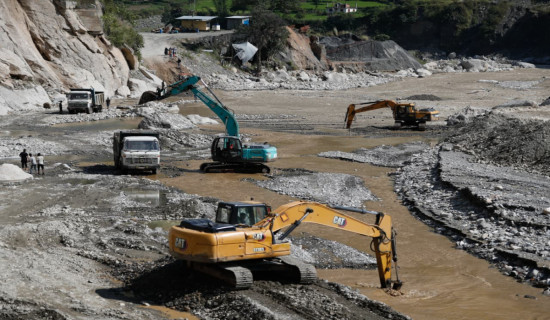- Friday, 10 October 2025
Stone-age tools discovered in Patu, Bardibas
By Rabindra Upreti,Bardibas, jun,1 : The archaeological sites of Patu in Bardibas-3 have garnered increasing attention and intrigue following the successive discoveries of rare and astonishing stone tools, offering a glimpse into human civilisation from thousands of years ago.
This area is part of the Ratu Civilisation. The discovery of Stone Age tools was a surprise for the researchers in the Department of Archaeology.
From the perspective of anthropology and archaeology, the Ratu Civilisation is filled with mystery and fascination.
According to the archaeologists, the stone tools scattered in this region indicate a possible vast repository of such tools beneath the surface.
Although German geologist, paleontologist and archaeologist Gudrun Corvinus conducted an in-depth study of the Ratu Civilisation 40 years ago, in 1985. Its significance remained confined to her publication.
Based on the findings of Corvinus research, a team from the Department of Archeology, in collaboration with Bardibas Municipality, initiated a seven-day study that is beginning to unveil more mysteries of the Stone Age.
According to Bhaskar Gyawali, Head of the Archeology Section and Dr. Manjil Hazarika, an expert from the Archeology Department of Cotton University, Assam, India, seven types of tools used by early humans have been collected from the nearly 10 square kilometres study area.
They showed that the collected tools are made from quartzite stone. The collected tools include unifacial choppers for cutting game and breaking bones, knives for slicing meat, scrapers for skinning animals, adzes for cutting wood and bamboo, points for digging edible roots from the ground and notches used like hearth tools.
Among the collected tools, the Sumatralithes resemble the ancient tools found in Java, Sumatra and Indonesia, according to Professor Dr. Hazarika.
He mentioned that the collected tools belong to the Mesolithic Age, that spans from 10,000 to 8,000 BCE.
Professor Dr. Hazarika said, “The collected tools are estimated to be around 7,000 years old. As the study progresses, they might turn out to be even older.”
The tools have been collected from an area covering about 10 square kilometres extending west of Ratukhola, east of Bhawsi Khola, north of Raimandal Hill and around Gauridanda, according to the team leader, Bhaskar Gyawali. Gyawali said, “So far, we have collected about 10 sacks of ancient tools from 18 sites in the area. Two sites are yet to be excavated.”
For Prof. Hazarika, who visited this region for the first time, the area holds the valuable heritage of an ancient civilisation.
He shared his experience, stating that despite conducting archaeological studies over the past 15 years in the region from India to Africa and Europe, he had never found such a vast repository of Stone Age tools before.
The Federation of Hotel and Tourism Entrepreneurs, Madhes Province, has also taken an interest in this area of Stone Age tools. President of the federation, Hiralal Gautam, said, “How the early humans, who lived a nomadic life for survival, arrived in the Bardibas region could be another topic of study.”
“However, the Stone Age tools here could draw global attention to the study regarding the development of civilisation and the emergence of modern humans,” he added.
After completing the excavation of all 20 sites, the collected tools will be processed, categorised, mapped and photographed. A report will be submitted to Bardibas Municipality and the Department of Archaeology by the end of this year, Gyawali informed.




-square-thumb.jpg)












